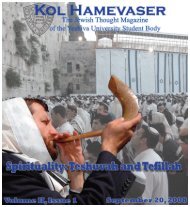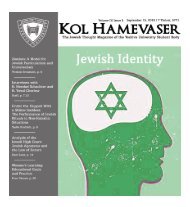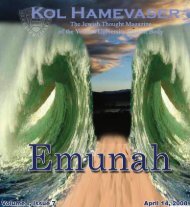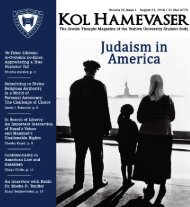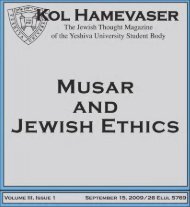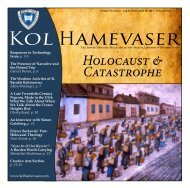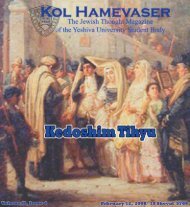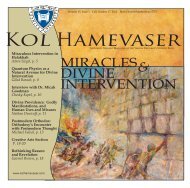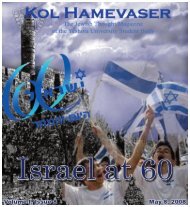Create successful ePaper yourself
Turn your PDF publications into a flip-book with our unique Google optimized e-Paper software.
BY: Daniel Fridman<br />
The Status of Haroset<br />
The place of haroset at the seder table is<br />
at once familiar <strong>and</strong> strange, predictable<br />
yet perplexing. While the presence of<br />
its companions, matsah <strong>and</strong> maror, i is m<strong>and</strong>ated<br />
by the Torah, haroset merits no scriptural<br />
references whatsoever. As we stare at its eclectic<br />
composition year after year, we cannot help<br />
but wonder what lies within the haroset, <strong>and</strong><br />
what these various elements are meant to represent.<br />
Given the absence of any biblical sources<br />
for haroset, the sages of the Mishnah debated<br />
whether there was even a rabbinic obligation<br />
to eat it. In the third mishnah of the final chapter<br />
of Massekhet Pesahim, the Tanna kamma<br />
takes the position that haroset is not a mitsvah, ii<br />
while R. Eliezer b. Tsadok maintains that<br />
haroset is indeed a mitsvah, though he does not<br />
specify what the performance of it entails. In<br />
his Perush ha-Mishnayot, Rambam notes that<br />
the <strong>Halakhah</strong> is in accordance with the position<br />
of the Tanna kamma. iii Subsequently, however,<br />
Rambam ruled in accordance with the position<br />
of R. Eliezer b. Tsadok, that the haroset is indeed<br />
a mitsvah of rabbinic origin. iv This conclusion,<br />
that haroset has the status of a rabbinic<br />
comm<strong>and</strong>ment, is shared by Rif <strong>and</strong> Rosh as<br />
well. v<br />
Six Dimensions of Haroset<br />
In elaborating the position of R. Eliezer b.<br />
Tsadok, the Talmud makes reference to three<br />
distinct commemorative functions that the<br />
haroset is meant to fulfill. vi First, R. Levi asserts<br />
that the haroset is zekher la-tapuah, an<br />
homage to the apple orchards vii in which the Israelite<br />
women delivered their babies under extremely<br />
difficult circumstances during the<br />
period of Jewish enslavement in Egypt. viii Second,<br />
R. Yohanan argues that the haroset is<br />
zekher la-tit, meant to commemorate the mortar<br />
which the Jewish people had to make<br />
throughout their forced labor in Egypt. In<br />
order to incorporate both of these elements into<br />
the haroset, Abbayei rules that one must have<br />
a sharp tasting element in the mix, corresponding<br />
to the tapuah, ix <strong>and</strong> that the composition<br />
of the haroset must be thick <strong>and</strong> pasty, corresponding<br />
to the mortar. Finally, the Talmud<br />
cites a Beraita which mentions a third element<br />
of the haroset, namely spices, which are meant<br />
to be incorporated zekher la-teven, in tribute to<br />
the straw which the Jewish people had to seek<br />
out in order to construct bricks, making it considerably<br />
more difficult for them to meet their<br />
daily quota of labor. x<br />
Commenting on this passage, the Tosafist-<br />
<strong>Halakhah</strong> <strong>and</strong> <strong>Minhag</strong><br />
Collective Memory <strong>and</strong> Haroset<br />
s xi cite a parallel section from Talmud<br />
Yerushalmi xii which notes a fourth commemorative<br />
dimension of the haroset, zekher la-dam,<br />
a memorial to the blood of the Jewish people xiii<br />
which was spilled over the course of the enslavement<br />
in Egypt. xiv Moreover, the Tosafists<br />
add a fifth dimension to the haroset, citing a<br />
previous ruling of the Geonim that fruits<br />
should be included in the recipe, xv parallel to<br />
the fruits that the Jewish people are compared<br />
to in Shir ha-Shirim. xvi<br />
A sixth <strong>and</strong> final commemorative dimen-<br />
sion of haroset is mentioned by the Tur, zekher<br />
la-maror. xvii In effect, the Tur argues that<br />
haroset has an overlapping function with bitter<br />
herbs, as it too commemorates the sheer bitterness<br />
of our bondage in Egypt. xviii As such, the<br />
Tur requires that some sour elements be added<br />
to the haroset.<br />
A Dialectical Perspective on Haroset<br />
Not all Rishonim subscribe to these six<br />
disparate elements of haroset. For example,<br />
Rambam only cites two explicitly, zekher latit,<br />
in commemoration of the mortar, <strong>and</strong><br />
zekher la-teven, the straw. xix In contrast, the<br />
Tur makes mention of five of the components,<br />
leaving out only zekher la-tapuah, xx but including<br />
zekher la-tit, la-teven, la-dam, la-maror,<br />
<strong>and</strong> the fruits to which the Jewish people were<br />
likened in Shir ha-Shirim. Rema subscribes to<br />
four of the elements, omitting zekher la-maror<br />
as well as zekher la-tapuah. xxi Thus, the positions<br />
of the various Rishonim present a considerable<br />
range of views regarding what aspects<br />
of the Jewish experience in Egypt are meant to<br />
be evoked by haroset.<br />
In any case, these six elements, when<br />
evaluated in total, may be subdivided into two<br />
distinct categories. Four of them, zekher la-tit,<br />
la-teven, la-maror, <strong>and</strong> la-dam, reflect different<br />
aspects of the suffering endured by our ancestors<br />
at the h<strong>and</strong>s of their sadistic Egyptian<br />
“The positions of the various Rishonim present a<br />
considerable range of views regarding what aspects<br />
of the Jewish experience in Egypt are<br />
meant to be evoked by haroset.”<br />
oppressors. On the other h<strong>and</strong>, zekher latapuah,<br />
commemorating the valor of the Jewish<br />
women whose faith was such that they<br />
could look hopefully to the future in the face<br />
of a terrifying present, as well as the inclusion<br />
of the fragrant <strong>and</strong> luscious fruits to which the<br />
Jewish people are favorably likened in Shir ha-<br />
Shirim, evoke unequivocally positive associations.<br />
As such, a remarkable dialectic is intrinsic<br />
to haroset itself: it is a singular composition<br />
whose elements simultaneously bear witness<br />
both to the very depths of our national degradation<br />
in Egypt as well as to the exclusive, unbreakable<br />
bonds which link the Jewish people<br />
with the Master of the Universe, as depicted in<br />
Shir ha-Shirim. It is a fascinating mixture with<br />
the capacity to, on the one h<strong>and</strong>, evoke the<br />
image of the blood of massacred Jewish babies<br />
flowing freely in the Nile River, <strong>and</strong>, at the<br />
same time, represent the birth of a new generation<br />
of Jewish children in the apple orchards,<br />
“As we stare at its eclectic composition year after year,<br />
we cannot help but wonder what lies within the haroset,<br />
<strong>and</strong> what these various elements are meant to represent.”<br />
in defiance of those who wished to destroy us.<br />
Even as each of its six elements bespeaks its<br />
own narrative, telling its own tale of suffering<br />
or triumph, each component coexists with all<br />
of the others. For all of the complexity of its<br />
components, the result is an organic, unified<br />
entity called haroset, whose totality is truly<br />
greater than the sum of its parts.<br />
Daniel Fridman is a third-year semikhah<br />
student at RIETS <strong>and</strong> is the Resident Scholar<br />
at the Jewish Center of Manhattan.<br />
i Shemot 12. In Pesahim 120a, the Talmud does<br />
distinguish between the statuses of matsah <strong>and</strong><br />
maror in the absence of the Korban Pesah, explicating<br />
that the mitsvah of matsah maintains<br />
de-Oraita status in the absence of the Korban<br />
Pesah, while maror does not. See also Rambam,<br />
Mishneh Torah, Hamets u-Matsah<br />
6:1,7:12. This important distinction notwithst<strong>and</strong>ing,<br />
the explicit treatment given to matsah<br />
<strong>and</strong> maror in the Torah should be<br />
contrasted with the haroset, which is never<br />
even mentioned.<br />
ii The presence of haroset at the seder, according<br />
to the view of the Tanna kamma that it is<br />
not a mitsvah, is explained by the Talmud in<br />
pragmatic terms: the haroset is merely meant<br />
to ameliorate the sharp taste of the maror. See<br />
Pesahim 116a.<br />
iii Rambam, Peirush ha-Mishnayot to Pesahim<br />
10:3.<br />
iv Idem, Mishneh Torah, ibid. 11:7. What is<br />
particularly fascinating regarding Rambam’s<br />
reversal is not only his conclusion that haroset<br />
is indeed a mitsvah mi-divrei Soferim (Rabbinic),<br />
in accordance with R. Eliezer b. Tsadok,<br />
but what appears to be a more fundamental<br />
reinterpretation of the nature of the mitsvah. In<br />
his Peirush ha-Mishnayot, Rambam asserts<br />
that, according to the rejected view of R.<br />
Eliezer b. Tsadok, since haroset is indeed a<br />
mitsvah, it requires a blessing reflecting the<br />
rabbinic comm<strong>and</strong>ment to consume the haroset<br />
Volume III, Issue 7 www.kolhamevaser.com<br />
of “al akhilat haroset.” However, in Mishneh<br />
Torah, in which Rambam actually rules in accordance<br />
with R. Eliezer b. Tsadok, no such<br />
blessing is recorded. The classical Maimonidean<br />
super-commentaries make note of<br />
this incongruity, <strong>and</strong> offer various explanations<br />
regarding the absence of a blessing on haroset.<br />
For one example, see Lehem Mishneh to Mishneh<br />
Torah, ibid. A particularly compelling explanation<br />
of the absence of the blessing has<br />
been related to me by R. Michael Rosensweig<br />
in the name of the Rav, who argued that Rambam<br />
classified the mitsvah of haroset as<br />
preparing this unique dish <strong>and</strong> having it present<br />
at the Seder, but not necessarily consuming it.<br />
Thus, since consumption of the haroset is not<br />
part of the mitsvah, no blessing over the<br />
haroset is warranted.<br />
v Rif to Pesahim 25b; Rosh to Pesahim 10:30.<br />
vi Pesahim 116a.<br />
vii Whether tapuah in this instance is best translated<br />
as an apple tree has been the subject of<br />
some contemporary debate, with certain authorities<br />
arguing that tapuah in this context is<br />
a reference to some kind of citrus fruit. For the<br />
purposes of this article, the conventional assumption<br />
will be maintained.<br />
viii See the beautiful aggadic passage in Sotah<br />
11b, which discusses the heroism of the righteous<br />
women of that particular generation in<br />
‘whose merit our ancestors were redeemed<br />
from Egypt.’ The reference to the apple tree<br />
emerges from Shir ha-Shirim 8:5.<br />
ix The fact that apples are not generally associated<br />
with a sharp taste has led some contemporary<br />
scholars to speculate that tapuah is best<br />
translated as a citrus fruit. See R. Hershel<br />
Schachter’s article on this subject: “Inyan ha-<br />
Tapuah she-ba-Haroset,” Be-Ikvei ha-Tson<br />
(Jerusalem: Beit ha-Midrash de-Flatbush,<br />
1997), p. 77.<br />
x See Shemot 5 for the narrative that details the<br />
evolution of Pharaoh’s decision to deny the<br />
Jewish people the raw materials necessary for<br />
the slave labor which they were forced to undertake<br />
in Egypt. The fact that the decision to<br />
deny the Jewish slaves straw caused considerable<br />
distress, over <strong>and</strong> above the suffering generated<br />
by the enslavement per se, is clearly<br />
reflected in the Talmud’s distinction between<br />
the commemoration of the mortar, which the<br />
Jewish people had to work with from the earliest<br />
days of their bondage, <strong>and</strong> the commemoration<br />
of the straw, which represented a new,<br />
even crueler phase of Egyptian brutality.<br />
xi Tosafot to Pesahim 116a, s.v. “Tsarikh lesammukheih<br />
ve-tsarikh le-kahuyeih.”<br />
xii Talmud Yerushalmi, Pesahim 10:3.<br />
xiii See Arukh ha-Shulhan, Orah Hayyim<br />
473:17, where R. Yehiel Mikhl ha-Levi Epstein<br />
cites, in explanation of this passage in the<br />
Yerushalmi, two different atrocities committed<br />
by the Egyptians against Jewish children.<br />
First, he cites Shemot 1:22, which records<br />
Pharaoh’s edict m<strong>and</strong>ating mass murder of<br />
newborn Jewish boys by drowning them in the<br />
Nile. Second, he cites the midrashic assertion<br />
15



